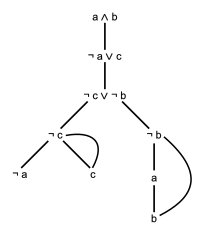Method of analytic tableaux

First, let's imagine we are trying to solve a puzzle with lots of different rules. Maybe it's a game of Clue or chess, and we need to figure out who did it, where they did it, and what weapon they used. But when we start looking at all the rules, it gets confusing and overwhelming!
That's where method of analytic tableaux comes in. It's basically a way of breaking down all the different possible outcomes and rules of a puzzle into smaller, more manageable parts.
We start with a big table (like a big piece of paper with lots of columns and rows). Each column represents a different possibility or rule that we need to consider. For example, maybe one column represents "Professor Plum did it" and another represents "Colonel Mustard did it."
Then, we start looking at all the different combinations of possibilities that could go in each column. We might have a row that says "Professor Plum in the Library with a Candlestick" and another that says "Colonel Mustard in the Conservatory with a Wrench."
As we fill in more and more combinations, we start to see which ones don't work based on the rules of the puzzle. For example, if we have a rule that says "Professor Plum can't be in the Library and the Ballroom at the same time," we can eliminate any rows that include both of those possibilities in the same column.
Eventually, we'll narrow down all the possibilities until we have a final answer that solves the puzzle based on all the rules.
So in summary, the method of analytic tableaux is a way of breaking down a complex puzzle or problem into smaller parts and eliminating possibilities based on rules and constraints until we are left with the correct solution.
That's where method of analytic tableaux comes in. It's basically a way of breaking down all the different possible outcomes and rules of a puzzle into smaller, more manageable parts.
We start with a big table (like a big piece of paper with lots of columns and rows). Each column represents a different possibility or rule that we need to consider. For example, maybe one column represents "Professor Plum did it" and another represents "Colonel Mustard did it."
Then, we start looking at all the different combinations of possibilities that could go in each column. We might have a row that says "Professor Plum in the Library with a Candlestick" and another that says "Colonel Mustard in the Conservatory with a Wrench."
As we fill in more and more combinations, we start to see which ones don't work based on the rules of the puzzle. For example, if we have a rule that says "Professor Plum can't be in the Library and the Ballroom at the same time," we can eliminate any rows that include both of those possibilities in the same column.
Eventually, we'll narrow down all the possibilities until we have a final answer that solves the puzzle based on all the rules.
So in summary, the method of analytic tableaux is a way of breaking down a complex puzzle or problem into smaller parts and eliminating possibilities based on rules and constraints until we are left with the correct solution.
Related topics others have asked about:
